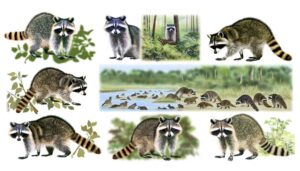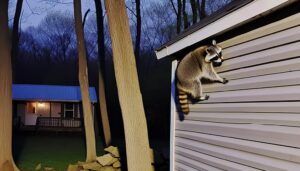How Far Do Raccoons Travel?
Raccoons typically travel between 1 to 3 miles per night, with their movement largely driven by food availability, habitat type, and seasonal behaviors. Field studies using radio telemetry confirm these travel patterns, and factors such as mating behaviors and territorial claims further influence their nightly journey.
Urban raccoons tend to have smaller, more predictable ranges due to abundant food and shelter, while rural raccoons cover larger areas. Additionally, seasonal variations impact their travel distances, with behaviors changing in response to environmental conditions.
To explore the complexities behind these travel patterns and their ecological impacts, further detailed insights are essential.
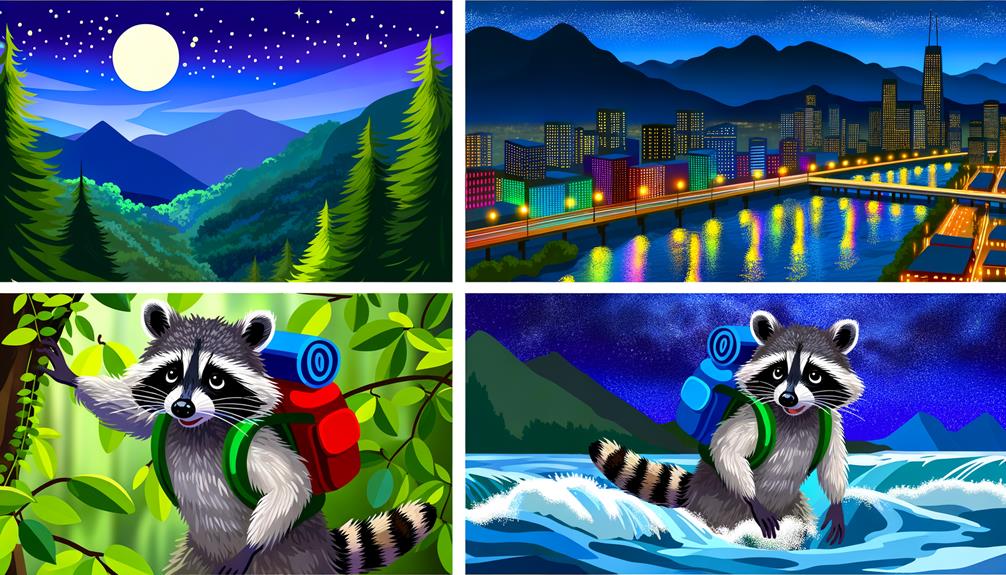
Key Takeaways
- Raccoons typically travel 1 to 3 miles per night.
- Their home range can span up to 20 square miles.
- Urban raccoons travel shorter distances due to higher food density.
- Rural raccoons may travel further due to dispersed resources.
- Seasonal behaviors influence nightly travel distances and range.
Average Travel Distance
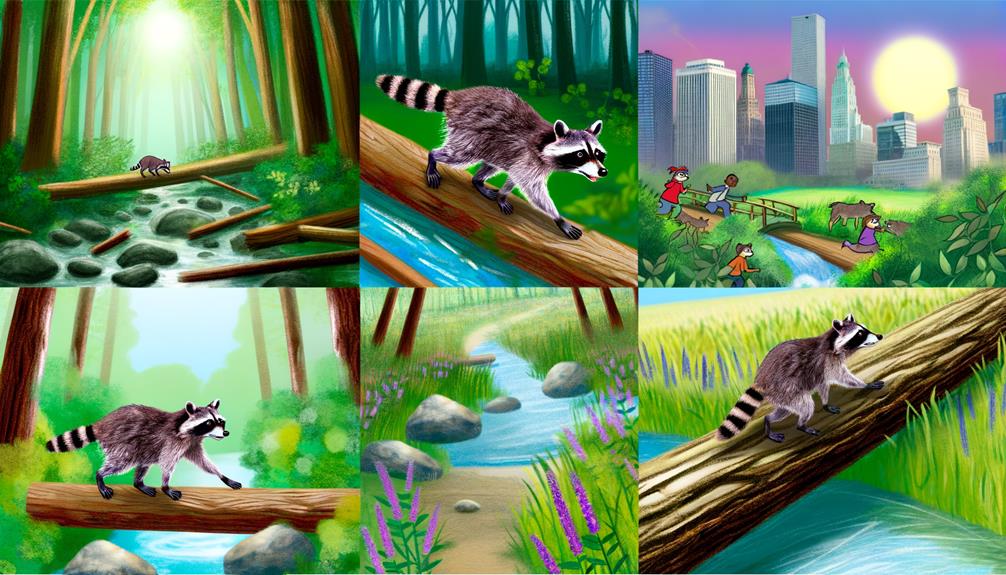
A raccoon's average travel distance can range from 1 to 3 miles per night, depending on factors such as food availability, habitat type, and seasonal behaviors. Extensive field studies utilizing radio telemetry have confirmed these nocturnal mammals' movement patterns, offering valuable insights into their spatial ecology.
Data indicates that raccoons exhibit considerable variability in their nightly travel distances, often influenced by their immediate environmental context. For instance, raccoons in urban areas may traverse shorter distances due to readily available food sources, whereas those in rural or forested regions might cover larger areas.
Additionally, their home range, which can span up to 20 square miles, provides a broader context for understanding these nightly excursions, emphasizing the species' adaptability and resourcefulness.
Factors Affecting Travel
Several vital factors influence the travel behavior of raccoons. These include the availability of food sources, habitat and shelter conditions, and requirements related to mating and territoriality.
Empirical studies indicate that raccoons may traverse varying distances depending on the spatial distribution of resources and environmental constraints. Understanding these determinants is essential for predicting raccoon movement patterns and managing their populations effectively.
Food Source Availability
Food source availability greatly influences the travel patterns and distances covered by raccoons. Scientific studies indicate that raccoons (Procyon lotor) are opportunistic feeders, consuming a wide array of food items including fruits, insects, and human refuse.
The density and distribution of these food resources directly impact their spatial behavior. Data show that in food-abundant environments, raccoons exhibit reduced travel distances, often between 1 to 3 kilometers per night.
Conversely, in areas with scarce food sources, their nightly range can extend up to 10 kilometers. Seasonal variations also play a critical role, with raccoons increasing their foraging range during periods of food scarcity, such as winter months.
Understanding these patterns is essential for wildlife management and urban planning.
Habitat and Shelter
Raccoon travel patterns are greatly influenced by the availability and distribution of suitable habitats and shelter. These nocturnal mammals favor areas with dense vegetation, water sources, and ample tree cover. Research has shown that raccoons can travel up to 18 kilometers in a single night when exploring or foraging, but they typically stay within a range of 1 to 3 kilometers if their habitat provides adequate resources.
Urban environments, with their myriad hiding spots and food sources, can also support raccoon populations, often leading to smaller travel ranges. Seasonal changes further affect travel distances, with raccoons expanding their range in warmer months and seeking more localized shelters during colder periods to conserve energy and maintain body heat.
Mating and Territory
The travel patterns of raccoons are greatly influenced by mating behaviors and territorial instincts, which dictate the distances and directions they traverse during breeding seasons.
Male raccoons, in particular, exhibit increased mobility, often expanding their range significantly to locate potential mates. Studies have shown that males can travel up to 18 kilometers in a single night during peak mating periods.
Females, on the other hand, tend to remain within established territories, typically ranging between 1 to 3 kilometers. Territorial boundaries are marked and defended through scent marking and physical confrontations.
The overlap of territories is common among females, but males usually maintain exclusive areas to maximize mating opportunities. These behavioral patterns are critical drivers of raccoon travel distances and distribution.
Urban Vs. Rural Ranges
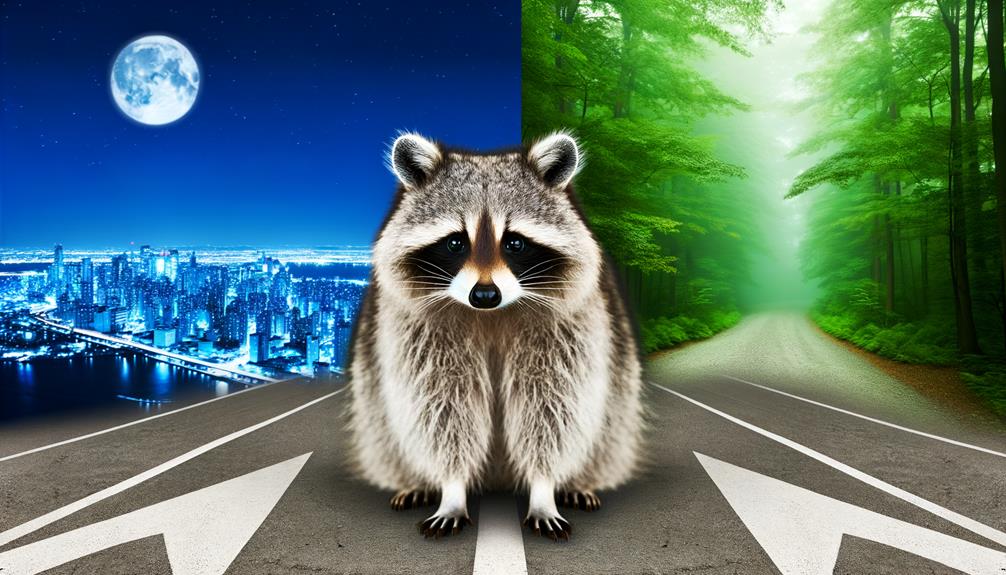
The movement patterns of raccoons vary substantially between urban and rural environments. In urban areas, raccoons tend to have smaller home ranges, often limited to 1-3 square kilometers, due to the availability of abundant food sources and shelter.
Conversely, rural raccoons typically cover larger areas, ranging from 3-20 square kilometers, as they need to traverse more extensive distances to locate sufficient resources.
Urban Raccoon Travel Patterns
While urban raccoons typically have smaller home ranges due to the abundance of food and shelter, their rural counterparts often travel greater distances to meet their survival needs. Urban raccoons exhibit distinct travel patterns that are shaped by their environment. Key factors influencing their movement include:
- Food Availability: Urban areas provide plentiful resources through garbage, pet food, and other human waste.
- Shelter Options: Buildings, attics, and sewers offer secure nesting sites, reducing the need for extensive travel.
- Human Activity: Raccoons often adjust their activity patterns to avoid human interaction, becoming more nocturnal.
- Territorial Overlap: Higher population densities in urban settings lead to smaller but overlapping territories.
These factors collectively result in a more confined and predictable travel range for urban raccoons.
Rural Raccoon Movement Habits
Rural raccoons exhibit significantly larger home ranges compared to their urban counterparts, often spanning several square miles to access dispersed food sources and suitable shelter. Studies indicate that rural raccoon home ranges can extend from 2 to over 10 square miles, influenced by the availability of food, water, and den sites.
These animals typically travel longer distances nightly, averaging 1 to 2 miles, to forage across diverse habitats such as forests, wetlands, and agricultural lands. Seasonal variations also impact movement patterns; during periods of food scarcity, raccoons may increase their foraging range.
In contrast, urban raccoons benefit from abundant, localized resources, resulting in smaller, more concentrated home ranges, often less than one square mile.
Seasonal Travel Patterns
Seasonal travel patterns of raccoons exhibit significant variation influenced by changes in food availability, weather conditions, and reproductive cycles. Studies indicate that raccoon movement can be categorized into several distinct patterns:
- Spring Dispersal: Juvenile raccoons leave maternal territories in search of new habitats, often traveling several kilometers.
- Summer Foraging: Increased activity is observed as raccoons exploit abundant food sources, leading to expanded home ranges.
- Fall Preparation: Movement intensifies as raccoons accumulate fat reserves for winter, focusing on areas with high food density.
- Winter Denning: Raccoons reduce travel and enter a state of torpor, staying within a limited range around their dens.
These patterns reflect adaptive strategies essential for survival and reproduction, driven by environmental and biological factors.
Impacts on Ecosystems
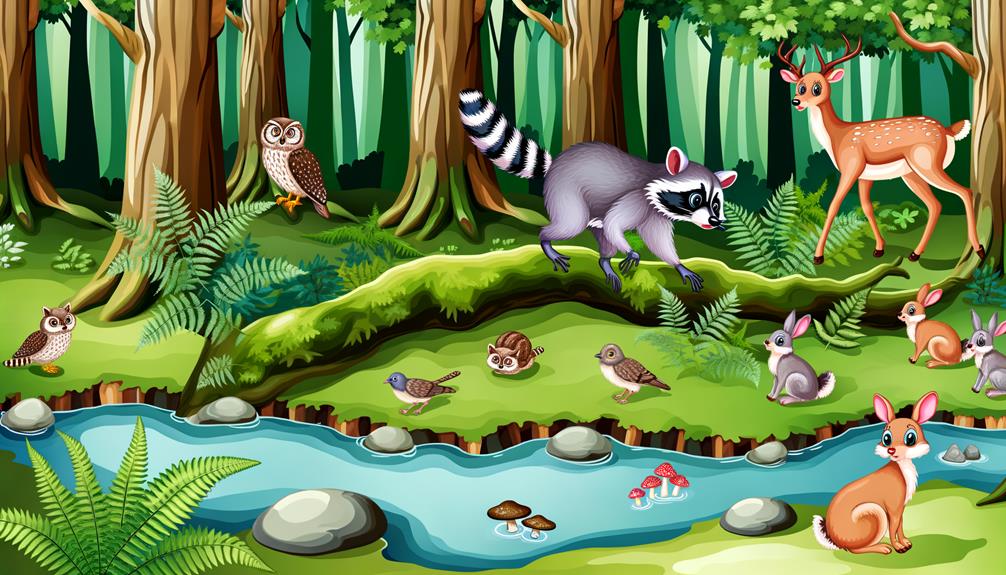
Understanding the seasonal travel patterns of raccoons is fundamental to evaluating their impacts on ecosystems, particularly as their movement and behavior influence species interactions, resource distribution, and habitat dynamics. Raccoons, as opportunistic feeders, can affect the abundance and diversity of prey species, leading to changes in local biodiversity. Moreover, their foraging activities often result in the dispersal of seeds, impacting plant community composition and regeneration processes. These dynamics are critical for maintaining ecological balance and can be assessed through detailed field studies and data analysis.
| Impacted Factor | Effect of Raccoon Movement |
|---|---|
| Species Interactions | Predation and competition |
| Resource Distribution | Altered availability |
| Habitat Dynamics | Changes in vegetation |
| Biodiversity | Variation in species richness |
| Seed Dispersal | Enhanced plant propagation |
Human-Wildlife Interactions
Human-wildlife interactions with raccoons are increasingly prevalent in urban and suburban areas, driven by the animals' adaptability and opportunistic behavior. This trend requires a thorough understanding of their movement patterns and ecological impacts. Raccoons often exploit anthropogenic resources, leading to increased encounters with humans.
Key areas of focus include:
- Habitat Utilization:
Raccoons thrive in environments with abundant food and shelter, often found in human-dominated landscapes.
- Movement Patterns:
Studies indicate raccoons can travel up to 10 miles within urban settings, influenced by resource availability.
- Ecological Impact:
Their foraging behavior can disrupt local ecosystems, affecting native species and biodiversity.
- Human Health Concerns:
Raccoons can be vectors for diseases like rabies and leptospirosis, requiring effective management strategies.
Understanding these factors is essential for mitigating negative interactions.
Conclusion
To sum up, raccoons, those determined little wanderers, travel remarkable distances influenced by a variety of factors like habitat, seasonality, and food availability.
Urban raccoons, clearly appreciating the modern conveniences, display different travel patterns compared to their rural counterparts.
Their movements, although appearing capricious, have substantial ecological effects and often lead them to encounter humans, adding another layer of complexity to the already intricate web of human-wildlife interactions.
Undoubtedly, the raccoon's journey showcases adaptability and the unforeseen outcomes of urban expansion.

